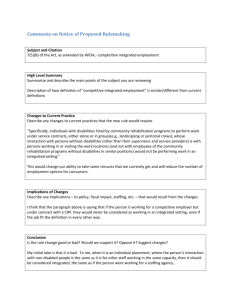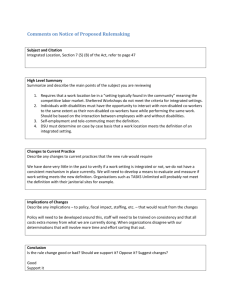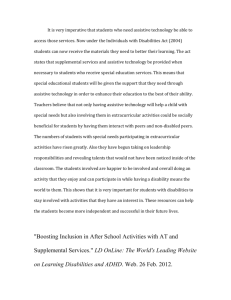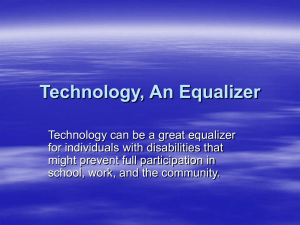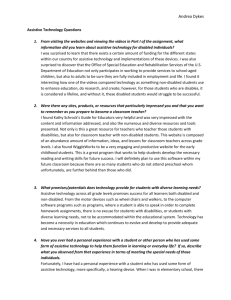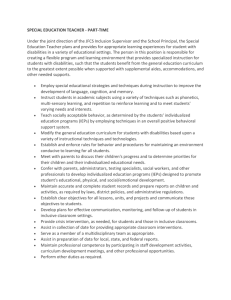File - Ms. Mary Hitchner
advertisement
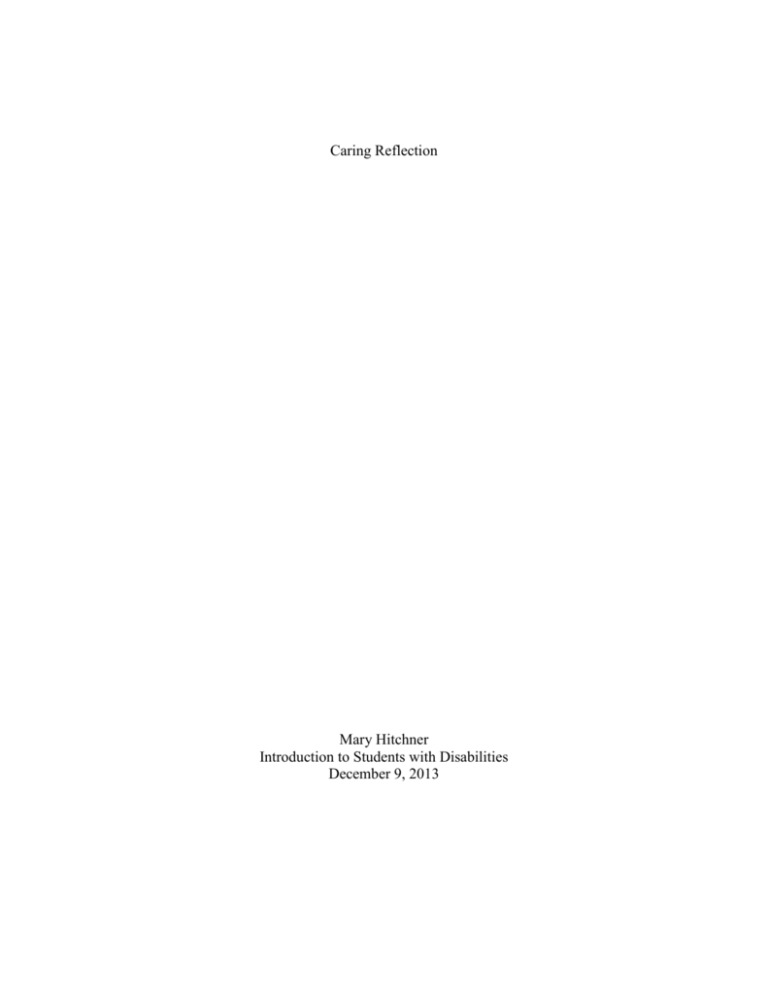
Caring Reflection Mary Hitchner Introduction to Students with Disabilities December 9, 2013 When educators work with students, they need to have some level of caring and sensitivity for their pupils. Teachers need to have a desire for their students to do well academically and in life in general. They also need to be sensitive to their students’ particular academic and emotional needs. Students greatly benefit when they have leaders who care about them and who want them to succeed. By completing the Inclusion research paper, Technology Integration paper, and the Social Skills paper, I have learned that it is crucial that educators, including myself, always take their students into account when teaching and lesson planning. The students need to be at the forefront when teachers do their jobs. Their needs and their learning are more important than other aspects of teaching. I have learned to be a caring and sensitive professional because I take students’ strengths and weaknesses into account when I teach, and I can utilize technology to help students who have disabilities and special needs. In the Inclusion paper, I explored the benefits of students with disabilities and nondisabled students when they are all in an inclusive classroom. All of these students are benefited academically, socially, and emotionally. According to Hitchner, students are academically benefited when “Being in an inclusive classroom allows students with disabilities to learn and work alongside their non-disabled peers” (2013, Benefits of Inclusion in Classrooms). These students are able to work with and learn beside each other in an inclusive classroom. It is important that teachers keep in mind that students with disabilities do not need to be separated in order for learning to take place. In addition to being benefited academically, students with and without disabilities can also benefit socially. Students of all learning rates have the opportunity to “Rather than spending the majority of the school day with other mildly disabled students, they spend the school day with students of all levels, disabled and non-disabled” (Hitchner, 2013, Benefits of Inclusion in Classrooms). This aids all students in that they socialize with students who are unlike them because they spend time with each other rather than being apart. As a teacher, this has impacted me because I was always under the impression that students with and without disabilities learn better when they are separate, but all students need the social aspect of being with those who are different than they are. Students with disabilities and non-disabled students benefit emotionally from inclusion in ways similar to the social benefits. Both sets of students emotionally benefit when the students with disabilities feel accepted and the non-disabled students accept the differences: “When mildly disabled students spend time with non-disabled students, their self-esteem levels will usually increase. This can be done through encouragement from their teachers and other students (Hitchner, 2013, Benefits of Inclusion in Classrooms). Teachers should always encourage their students, and their caring and sensitive example will be followed and copied by their students. In the Assistive Technology assignment, I used a case study as an example of how technology, or anything that assists a student with disabilities in any way, could affect his or her academic performance and learning. Using my knowledge of the student’s needs, I designed an academic goal and an assistive technology application that would be used for the student to succeed. My case study student, Corey, has trouble with writing organization and prewriting. My goal for him was to: “should be able to write a paragraph that he as well as any teacher, student, or parent could understand after reading. He needs to be comfortable with writing and not experience any anxiety, or at least very little anxiety” (Hitchner, 2013, Assistive Technology). Corey needed to use a computer writing software called Draftbuilder “to enter information into specific areas, which will help him with organization as it shows him exactly where certain information needs to go” (Hitchner, 2013, Assistive Technology). This assignment helped me to realize that there is a plethora of technology aides that students with disabilities can use to guide them in the learning process. It helped me to solve Corey’s problem by implementing a new piece of assistive technology that he had never used before. I learned that as a teacher, I will always have students who need special accommodations and aides that I can contribute to help them achieve academically. In the Social Skills assignment, I looked at students with disabilities and their social difficulties and hardships. I realized that students with disabilities often experience “negative interaction with others, having unfamiliarity with social situations, and feeling as if they do not measure up to the level of the other students because of their learning differences” (Hitchner, 2013, Social Skills in Mildly Disabled Students). These students may have had bad experiences with others who teased them or teachers who reacted badly to their disabilities. Because of their negative incidents with others, they may shy away from spending time with other students, with disabilities or without. They also may not know how to act or react when with others which would make adults without disabilities feel a little nervous or apprehensive. To tie into the already present apprehension or fear, students with disabilities often feel inferior to non-disabled students. To deter the difficulties that students with disabilities often have, teachers can use specific strategies to make them feel comfortable in their surroundings. Teachers can “integrate teaching social skills into their classroom management plans. As a year-long activity, educators can keep track of how students act while working individually, in pairs or small groups, and as a whole group” (Hitchner, 2013, Social Skills in Mildly Disabled Students). This can be done through keeping a rubric attached to each student’s desk. When the students accomplish what is on the rubric such as keeping hands and feet to self or listening to who is talking, they can give themselves a checkmark or a star on the rubric next to the corresponding behavior. Students can also utilize the fine arts in order to learn social skills. This can be done through choosing “a topic that is important and relevant to them such as bullying or making friends, create a short skit about it, and the teacher can film it for them” (Hitchner, 2013, Social Skills in Mildly Disabled Students). These students will be able to work with others, and all will be given a chance to perform in some way. Lastly, students can be split into reading groups based on their reading level. The teacher can take each group separately and have each one read their leveled readers that are educationally relevant to the curriculum. Having students of all reading levels do this “gets the students to read aloud, working on their social skills and reading at the same time” (Hitchner, 2013, Social Skills in Mildly Disabled Students). There are specific teaching strategies that I would use to address the needs of students with disabilities. These strategies are giving students with disabilities respect in the same way I would treat non-disabled students, focusing on students as individual learners with needs, and keeping in mind that little changes can make a big difference in a classroom of non-disabled and students with disabilities. All of these strategies should benefit students when I properly implement them. Students with disabilities should be treated in a way similar to their peers who do not have disabilities. Using inclusive practices can help students with disabilities tremendously as they learn in school. As shown in “Benefits of Inclusion in Classrooms,” the practice of educating students with disabilities in a classroom with students who do not have disabilities can be very beneficial to both parties. When students who have significant learning differences are together, they tend to learn from each other; “When non-disabled students succeed, it is only natural for the mildly disabled students to desire to succeed as well. The setting provides a little more push to achieve and succeed” (Hitchner, 2013, Benefits of Inclusion in Classrooms). These students will attempt to succeed when they are surrounded by students who are trying as well. Some students need to be told how to handle themselves in situations, “use quiet voice; follow directions; notice your neighbor; keep hands, feet, and objects to self; and, focus on the task to be completed” (Hitchner, 2013, Social Skills in Mildly Disabled Students). All students can use these pointers at some point in their education careers, so it would be helpful for all students to hear these tips on a regular basis. Students can work together on projects, as both students with disabilities and non-disabled students will all have a different talent or point of view to contribute, “the students can discuss how to make friendships and be respectful” (Hitchner, 2013, Social Skills in Mildly Disabled Students). Next, I see the importance of treating students as individuals with different needs. As shown in the Assistive Technology assignment, the student, Corey has “a problem with focusing on the topic of his paragraphs and putting his sentences into a logical order…However, he does write with decent writing mechanics and punctuation, and his ideas make a contribution towards his writing” (Hitchner, 2013). He had a specific problem that needed to be altered, so a specific goal was outlined; “Corey should be able to learn how to prewrite using outlining and brainstorming so that he might write an organized paragraph” (Hitchner, 2013, Assistive Technology). A specific computer program, Draftbuilder, was chosen for Corey so he could better prewrite and outline his ideas for writing as evidenced in the Assistive Technology paper. Lastly, it is important for me to keep in mind that not all alterations to the curriculum or teaching strategies be substantial. Some changes can be quite small, yet still have a big impact on student learning. For example, in the Social Skills assignment, I showed how simple changes such as students keeping track of their own behavior can help the development of social skills (Hitchner, 2013). These students are given responsibility for their own behavior when they see where they do well and in which areas they need to work on. Students can also read leveled readers out loud with other students who are at the same reading level as they (Hitchner, 2013, Social Skills in Mildly Disabled Students). Students with and without disabilities will be able to listen together while reading out loud. Giving students the opportunity to explore their artistic sides through drama also aides them as they try to learn and socialize (Hitchner, 2013, Social Skills). Any student who benefits from these small changes will be able to make the best out of their mild disability. In conclusion, I am a caring and sensitive teacher who accepts students for their individual needs and talents because I think about their needs while I teach and when I lesson plan. I utilize technology and any aids as they are useful tools that can be used to assist students with disabilities in ways better than human interaction can. Also, there are certain instructional practices and strategies that I would use to address the needs of students with disabilities. I would respect and treat all students as individuals, reach each student’s different needs, and embrace the idea that even small changes can make a big impact in student learning and growth. References Hitchner, Mary. (2013). Assistive Technology. Unpublished Manuscript, Fairleigh Dickinson University. Hitchner, Mary. (2013). Benefits of Inclusion in Classrooms. Unpublished Manuscript, Fairleigh Dickinson University. Hitchner, Mary. (2013). Social Skills in Mildly Disabled Students. Unpublished Manuscript, Fairleigh Dickinson University.
